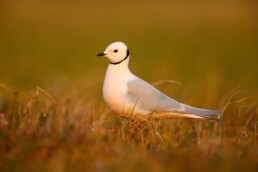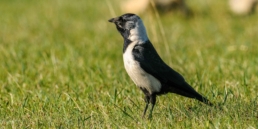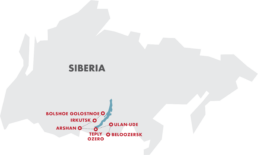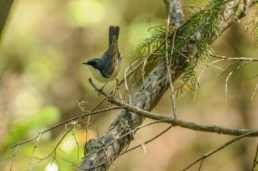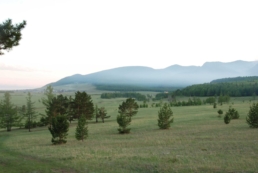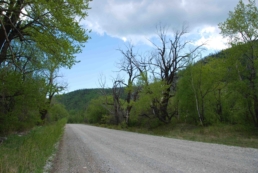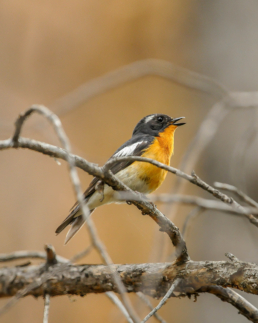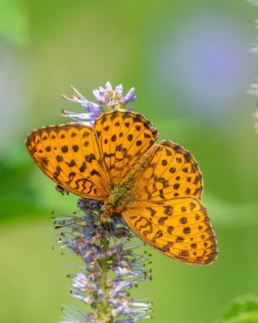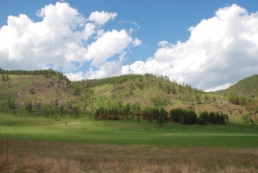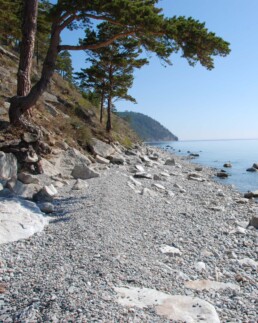Your Siberia itinerary
Day 1: Arrival in Irkutsk
Clients depart from home towards the most significant city near Lake Baikal, Irkutsk. For those who wish to arrive early, please contact the RBT office and we will gladly help you with extra hotel arrangements.
Night: On aircraft.
Day 2: Irkutsk
We will meet for breakfast at 9 am in the Marriott Hotel lobby, keen to embark on this unique Siberian adventure. Our first day is spent exploring this fantastic city, sometimes called ‘the Paris of Siberia’. Many of the ancient wooden buildings have been preserved and showcase ornate and hand-carved decorations. The centre of the city is located on the tentative list of UNESCO World Heritage Sites. We will take a guided city excursion, explore the old city centre, walk along the Angara River, and visit, among other landmarks, the Epiphany Cathedral.
Night: **** Marriott Irkutsk City Center Hotel, Irkutsk
Day 3: Novo-Leninskiy Marshes; afternoon transfer to Bolshoye Goloustnoye
We start our venture with a visit to the Novo-Leninskiy Marshes (New Lenin Marsh). This wetland is located within the city limits and consists of many overgrown lakes with reeds, and moist meadows filled with territorial birds. These lakes are teeming with various waterfowl, sometimes Falcated Duck is even found here, but the undisputed star of the show here is Yellow-breasted Bunting. Males can be heard singing right across the marsh. Nearby we can see and hear Common Reed Bunting and Black-faced Bunting as well. This is one of the best places to encounter the mysterious Pallas´s Grasshopper Warbler, while Eastern Marsh Harrier patrols the reedbeds, and we will search for the diminutive Baillon´s Crake. Long-tailed Rosefinch, Azure Tit and many other exciting species are frequent visitors to this area.
Bolshoye Goloustnoye is a small Siberian village located two hours from Irkutsk. The town has approximately 700 residents of whom most have lived all their lives here. All the buildings are built in a classic wooden style, with the road leading to the town being equally primitive! Our first stop is the meadows of the Ushakovka River, a regular haunt of Swinhoe’s Snipe which gives its aerial display flight above the fields. Mature trees attract Black Woodpeckers, and Swinhoe’s Robin and Red-flanked Bluetail can be seen in patches of pine. The open meadows are inhabited by Brown Shrike, and we will be keeping an eye on the sky for Booted Eagles and Crested Honey Buzzards. Back in the village, we will check in to our attractive guesthouse near Lake Baikal.
Night: Russkoye Podvorye Resort, Bolshoye Goloustnoye
Day 4: Bolshoye Goloustnoye
Dawn is early, and we start with a visit to the dense Taiga forest. This is the habitat of some classic and beautiful Siberian birds. Here we can find Pallas´s Leaf Warbler, Yellow-browed Warbler, Orange-flanked Bush-robin, White´s Thrush and even Rufous-tailed (Swinhoe´s) Robin are sometimes seen. Woodpeckers are frequently observed, Black, Gray-headed and Little Spotted woodpeckers are all possible. Buntings are the dessert, with the magnificent Chestnut and Yellow-browed Buntings being the most prominent targets. After breakfast, we will visit some captivating taiga meadows in a small river valley, with colourful wildflowers and an extensive selection of butterflies on offer. Here Gray´s Grasshopper Warbler, Lanceolated Warbler, Baikal Grasshopper Warbler, Chinese Grasshopper Warbler, as well as Naumann´s, Dusky, and Red-throated Thrush are the key targets.
After an afternoon break, we will enjoy a leisurely walk in the village to have a closer look at the traditional wooden houses. We will have an excellent chance to come across birds like Hill Pigeon, Barn Swallow of the race ‘tytleri’ (all red belly and breast) and Lesser Whitethroat. On the nearby open grassland plains, Blyth’s Pipit and Thick-billed Warblers are breeding. A colony of handsome Daurian Jackdaws will undoubtedly receive a lot of attention as well! In the evening we return to our guesthouse where we will enjoy a delicious local meal.
Night: Russkoye Podvorye Resort, Bolshoye Goloustnoye
Day 5: Bolshoye Goloustnoye to Arshan
In the morning, we start driving towards the village of Arshan, which is renowned for its mineral springs. During the drive, we make several stops where Pallas’s Warbler and Siberian Chiffchaff will hopefully be added to our list. The Siberian Chipmunk is one of the smaller mammals living in the Taiga forest; it is the only species of Chipmunk found outside of North America, and we have a good chance of finding it near Arshan. After a long day of driving, we arrive in the early evening at the small resort village of Arshan.
Night: Tuyana Hotel, Arshan
Day 6: Tunka Marshes
Today we visit the Tunka Marshes, an area of snow-capped peaks, woodland patches, grassy meadows and several small lakes with reedy margins. Before reaching Tunka, an area of bushes is worth checking for Siberian Rubythroat, Tree Pipit and Pine Bunting. In the meadows, Richard’s Pipits are common, while stands of trees and scrub hold Eurasian Wryneck, Northern and Brown Shrikes and perhaps a Thick-billed Warbler. A walk around Tunka Marshes may reveal Eurasian Bittern, Stejneger’s Scoter, Common Pochard, Greater Spotted Eagle, White-winged Tern, Siberian Stonechat and singing Yellow-breasted Buntings. Tunka is also reliable for calling Japanese Quails, although our chances of seeing one are slim. Scarcer birds occurring at Tunka include Black Grouse, White-tailed Eagle, Eastern Buzzard and Little Gull. In the evening we return to Arshan, where we will visit the magnificent preserved Buddhist temple of Bodhidharma or Hoymorsky Datsan.
Night: Tuyana Hotel, Arshan
Day 7 - 8: Sayan Mountains
In the morning we leave beautiful Arshan behind us and head west along a picturesque road. We travel through a valley surrounded by snow-capped peaks, to eventually climb up a mountain plateau near the border with Mongolia. This scenic area is located at the base of the highest mountain of the Eastern Sayan – Mount Munku Sardyk (3,491 m). Here we will seek out the elegant Red-throated Thrush and Güldenstädt’s Redstart, but the main goal has to be Pallas’s Rosefinch. All three of these species are undoubtedly stunners, but the latter is probably the most amazing. The rosefinch has a deep pinkish-brown colour with white primaries and a subtle light pinkish throat patch. In tracts of birch forest, we will many Two-barred Warblers frantically calling. There are no hotels in this mountainous region, and as such we have organized a cosy tented camp for our time here. Our meals will be cooked over an open fire with an endless glittering sky above our heads!
Night: Private Tented camp, Arshan Mountains
Day 9: Sayan to Teply Ozero
We will have a final walk around our camp before we leave Sayan and drive to the southern shores of Lake Baikal. Along streams and mountain rivers in this area we often see White-throated Dippers – this is also the habitat of a rare and mysterious bird, the Solitary Snipe. It favours fast-flowing streams at high elevations and is tricky to spot. If we are lucky, we may find the odd pair of Asian Rosy-Finch here. During our drive, we stop to visit the small village of Kudrino where the gardens hold birds like Daurian and Common Redstarts, Eurasian Nuthatch and Azure-winged Magpie. An area of forest nearby may be productive for the scarce Siberian Bush Warbler, Olive-backed Pipit, Lanceolated Warbler and Common Rosefinch. Stands of silver birch dominate the place where we should locate the attractive Chestnut Bunting, Oriental Turtle Dove, Eurasian and Baikal Bullfinches, Hawfinch, and various Woodpeckers. We expect to arrive at our hotel near Teply Ozero in the early evening. We will spend three nights here on the shores of Lake Baikal.
Night: Belosnezka Hotel, Vydrino Village
Day 10 - 11: Birding at Teply Ozero
Birding in this fabulous place is something that must be experienced to believe. The location, between Lake Baikal and a nearby high mountain range, creates the wettest area in southern Siberia. These conditions produce an area of unique vegetation. A combination of dark coniferous taiga with relic poplar forests makes the Teply Ozero area prosperous for wildlife. Be prepared for a plethora of new species – Oriental Cuckoo, White-backed, Three-toed and Grey-headed Woodpeckers, Red-flanked Bluetail, Olive-backed Pipit, Dark-sided, Asian Brown, Mugimaki and Taiga Flycatchers, Radde’s, Arctic, Yellow-browed, Pallas’s, and Two-barred Greenish Warblers, Siberian Blue and Swinhoe’s Robins, and Black-faced Bunting. Uncommon species known to occur in these forests include Yellow-browed Bunting, Siberian Jay, White’s, Eye-browed and Siberian Thrushes and, above the forest, White-throated Needletails. In the evenings we will wait for beautiful views over Lake Baikal as well as some short forays in search of Ural Owl, Great Grey Owl and Boreal Owl.
Night: Belosnezka Hotel, Vydrino Village.
Day 12: Teply Ozero to Ulan-Ude
In the morning we will make one more visit to Teply Ozero before we set sails for the Buryat capital of Ulan-Ude. This is a region dominated by steppe, salt lakes and small river valleys. This is a markedly different landscape from what we have previously witnessed. On the way, we will make several stops for birding, with a chance to find the rare and handsome Chestnut-eared Bunting. We will reach Buryatia in the early evening. Buryats are another indigenous people of Siberia, closely related to the Mongols that live to the south. Once in the city, we immediately feel its local flavour which will add colour to our journey. In the evening we can take a short walk to visit the largest Lenin-head statue in the world. We end a long day with a delicious local flavoured dinner.
Night: *** Baikal Plaza, Ulan-Ude.
Days 13: Ulan-Ude to Beloozersk
Early this morning, a transfer will be arranged to Nursultan Nazarbayev International Airport (NQZ), ensuring timely arrival for the Turkish Airlines flight to Istanbul, currently scheduled for departure at 3:20 a.m.
Night: No lodging
Day 15: Beloozersk to Ulan-Ude
We do some final birding, revisiting the regions of the previous days. In the afternoon we have the option to visit the Ivolginskiy Datsan, the only Buddhist spiritual centre of the former USSR. Eventually, we return to Ulan-Ude, where the tour concludes with a grand final dinner.
Night: *** Baikal Plaza, Ulan-Ude
Day 14: Birding the steppe of Beloozersk
An early start will see us arrive at an area of salt lakes near the village. This is a great place, with a high concentration of ducks and waders at this time of year. At times there are so many Ruddy Shelducks present that parts of the lake appear red! Alongside the numerous shelduck, we may find Whooper Swan, Slavonian and Black-necked Grebes and numerous ducks which may include small numbers of Long-tailed Duck and Smew. The open steppe habitat attracts Demoiselle Crane, Cinereous Vulture, Steppe Eagle, Upland Buzzard and Eurasian Hobby. In the tall grasslands, colourful Mongolian Larks are breeding, with males continually displaying. Blyth’s Pipit and Pallas’s Reed Bunting can be found nesting on the shores and in tall tufts of grass. The lakes here occasionally hold the very rare Swan Goose. On the muddy margins of the lake, we may find migrant shorebirds including Pacific Golden Plover, Red-necked, Long-toed and Temminck’s Stints, Eastern Black-tailed Godwit, Marsh Sandpiper, Pied Avocet and Little Ringed Plover. A walk-through riverside woodlands gives a good chance of finding migrant passerines, resting after a night of migration. On the ground, Daurian Partridge may be sighted scuttling away from us, while Golden Eagle, Lesser Kestrel, Azure Tit, Meadow and Black-faced Buntings are omnipresent. Upland Buzzards and even Saker Falcon can usually be found on the electrical pylons nearby. All in all, a great day awaits us!
Night: Private residence, Beloozersk
Day 16: Departure for Home
After a splendid holiday in Central Siberia, it is time to depart for home. We say our farewells at the Ulan-Ude Airport from where everybody boards their respective flights home.
Tour information
Focus
- Birds
- Mammals
- Russian culture
Group size
Min 6 - Max 10
The group will be always led by one birding leader and one assistant.
What's included in the Price?
All transport. All accommodations in twin rooming. All meals. All permits and national park entrances. Please note: Drinks, tips, possible visas and items of a personal nature including travel insurance, are not included.
Accomodation
Throughout the tour, we primarily use regular tourism hotels or lodges, all of which offer private facilities. On a few occasions, we may stay in basic lodges or hotels where shared facilities are encountered. In the larger cities, the hotels are very decent, and some are even rather lovely.
Difficulty
Our expedition to Lake Baikal is moderately intensive. Given the long days, we take full advantage during our excursions. Typically, we start the day early with some birding, accompanied by a light snack and coffee. We return later in the morning for breakfast when bird activity slows down. Midday is often spent transferring to new birding areas or taking a short break, followed by more birding in the afternoon and evening.
We’ll be doing some walking, covering up to 4-5 km per day, so a moderate level of fitness is required to comfortably complete these walks. Weather-wise, we generally expect cooler temperatures, though in recent years, temperatures have occasionally risen to nearly 30°C.
As for mosquitoes, we recommend bringing adequate repellents, though the best protection is to cover exposed skin. While we do expect to encounter some mosquitoes, our early-season timing means the majority of them will appear later in the year.
Flights
International flights are not included in the pricing. Please connect with the RBT office to find out your best connection to Russia.
Clothing - What to pack?
For our expedition to Russia, it’s essential to pack a variety of clothing to accommodate the diverse climates and activities we’ll encounter. Lightweight, easily washable, and quick-drying clothes are crucial for potentially hot days in the taiga and during longer walks. Be sure to bring sunglasses and a sun hat for sun protection.
It’s also important to pack lightweight yet warm layered clothing for early mornings, especially when on the water, as temperatures can drop significantly. This should include a warm hat, fleece, and light gloves to keep you cozy. Additionally, a light waterproof jacket is recommended to shield against unexpected rain showers. For footwear, opt for lightweight yet sturdy walking boots that can handle various terrains.
Ready for your next adventure?
Reserve your spot on our Lake Baikal expedition in Seberia now.
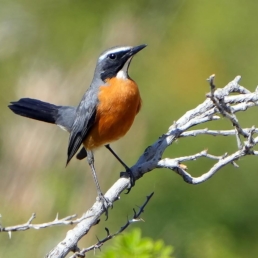
Related tours
From Altai Snowcocks to Mongolian Ground-Jays
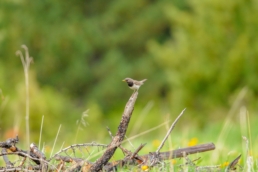
Birding the Far East
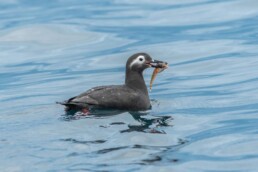
An expedition to the Indigirka Delta for Ross’s Gull & more
